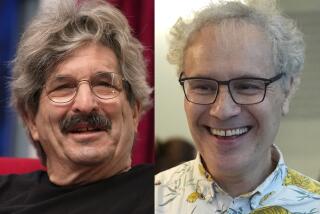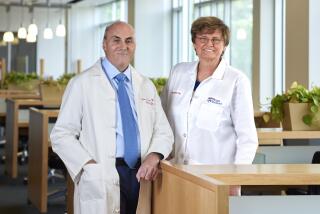James Allison and Tasuku Honjo win Nobel Prize for landmark cancer immunotherapy discoveries
- Share via
Two scientists who first harnessed the power of the immune system to fight incurable cancers have won the 2018 Nobel Prize in medicine or physiology.
The discoveries made by American researcher James P. Allison and Japan’s Tasuku Honjo have brought real hope of long-term survival to patients with a wide range of highly lethal cancers, including advanced melanoma, and colon and lung malignancies.
For the record:
1:45 p.m. Oct. 3, 2018An earlier version of this article said researcher James P. Allison plays the guitar in a rock band called the Checkpoints. He plays the harmonica.
In awarding the $1.01-million prize, the Nobel Assembly of Sweden’s Karolinska Institute hailed Allison’s and Honjo’s discoveries as “a landmark in our fight against cancer.”
The two scientists worked in separate labs and focused on different mechanisms within the immune system. But they both showed how key players called T-cells dial back their attack on cancer — and how to restore those cells’ will to fight.
Their findings have led to the approval of six new treatments for 11 types of cancer. In doing so, they have opened a new front in the treatment of cancer, adding immunotherapy to surgery, radiation and chemotherapy. To date, oncologists have treated hundreds of thousands of cancer patients with these drugs.
“These are clearly drugs that have improved the lives of cancer patients — the quality and quantity of their lives,” said Dr. Otis Brawley, the chief medical and scientific officer of the American Cancer Society.
In recognizing Allison and Honjo’s work, the Nobel committee has signaled that immunotherapy “was not a fad,” added Brawley, who considers Allison a close friend.

Allison is now based at MD Anderson Cancer Center in Houston, where he is married to fellow cancer researcher Dr. Padmanee Sharma and plays harmonica in a rock band called the Checkpoints. But he performed much of his early work at UC Berkeley.
He said Monday he did not set out to cure cancer. All he really wanted was “to know how T-cells work.”
“The dirty little secret of most scientists is the desire to know something that nobody else knows,” said Allison, who said he learned of the Swedish Academy’s honor early Monday morning while attending a conference of cancer researchers in New York.
At his laboratory in Berkeley during the early 1990s, Allison studied the T-cell protein called CTLA-4. Other scientists had already established that the protein acts as a brake on the action of T-cells, ensuring that these immune system warriors do not attack healthy tissue. Those researchers were exploiting its strength to treat auto-immune diseases, in which the immune system does just that.
Allison had a different idea for how those “brakes” could be used.
In cancer, he knew, the immune system was being tricked into applying those brakes. That gave malignant cells free rein to proliferate and spread.
Allison had designed an antibody that could home in on the CTLA-4 protein and prevent it from deploying its brakes. By 1994, he and his colleagues conceived a plan to use their “checkpoint inhibitor” on a mouse’s immune system as it responded to cancer.
As the year wrapped up, the scientists watched in amazement as their antibody lifted the natural brake that kept the immune system from unleashing its fury on cancers. Even mice with advanced cancers saw malignant cells disappear altogether, and the success was repeated in multiple trials.
The pharmaceutical industry showed little interest in these initial findings. But by 2010, Allison’s persistent efforts to apply this approach to humans could no longer be ignored.
Consider advanced melanoma, a diagnosis that for virtually all patients would lead to death within a year. One of Allison’s landmark clinical studies showed that close to half of those who received the treatment were still alive a year later. Many would go on to live for years.
In 2011, a CTLA-4 inhibitor called ipilimumab (marketed as the cancer drug Yervoy) was approved by the U.S. Food and Drug Administration as a treatment for metastatic melanoma.
“I was told many times that the immune system does not treat cancer,” said UCLA oncologist Antoni Ribas, who referred several patients to these early studies and went on to conduct several trials of immunotherapy drugs. ”Now everybody is convinced and wants to use these drugs.”
Around the time that Allison was making early strides on his work in California, Tasuku Honjo was performing a series of elegant experiments on a related immune system mechanism in his lab at Kyoto University in Japan.
In 1992, Honjo had discovered PD-1, another protein expressed on the surface of T-cells. His experiments were showing that like CTLA-4, PD-1 constrains the wrath of T-cells. When its function was disrupted in animal experiments, the immune system went after cancer and kept doing so — often, until it disappeared.
By 2012, a key study demonstrated that targeting PD-1 was effective in the treatment of patients with several different types of cancer.
Today, multiple immunotherapy drugs that block PD-1 have been approved by the FDA, including pembrolizumab (marketed as Keytruda) and nivolumab (marketed as Opdivo). While their cost and their safety remain concerns — treatment can run hundreds of thousands of dollars, and runaway immune system attacks can be life-threatening — they have transformed the treatment of cancers of the skin, lungs and more.

Ribas called the Nobel committee’s recognition of Allison’s and Honjo’s work “overdue, but very exciting.”
Today, there are patients who have survived for 18 years after a single round of immunotherapy, said Allison, who considers them cured. “Once you’ve got T-cells” empowered to fight a cancer, he said, “you’ve got that for the rest of your life.”
But he also acknowledged that they have not changed cancer treatment for all. While fewer than half of patients with certain cancers respond to any one immunotherapy drug, he said he is hopeful that combinations of drugs can be used together for greater effect.
One step likely to improve the effectiveness of checkpoint inhibitors is its use in conjunction with a new class of personalized immunotherapy drugs. In this approach, called CAR-T therapy, a patient’s own immune cells are removed from the body, trained to recognize and attack the patient’s own cancer, and returned to the body in vast numbers.
Altogether, some 40 cancer immunotherapy drugs are under development, and they’re being tested in thousands of trials.
Allison said scientists need to better understand “how these drugs work and how they might best be combined with other therapies to improve treatment and reduce unwanted side effects.”
But his tinkering with T-cells has already paid dividends far greater than he ever could have guessed.
It’s “a great emotional privilege to meet cancer patients who’ve been successfully treated” with immunotherapy, Allison said Monday. “They are living proof of the power of basic science.”
MORE IN SCIENCE
UPDATES:
2:30 p.m.: This story has been updated throughout with staff reporting.
This article was originally published at 2:40 a.m.







